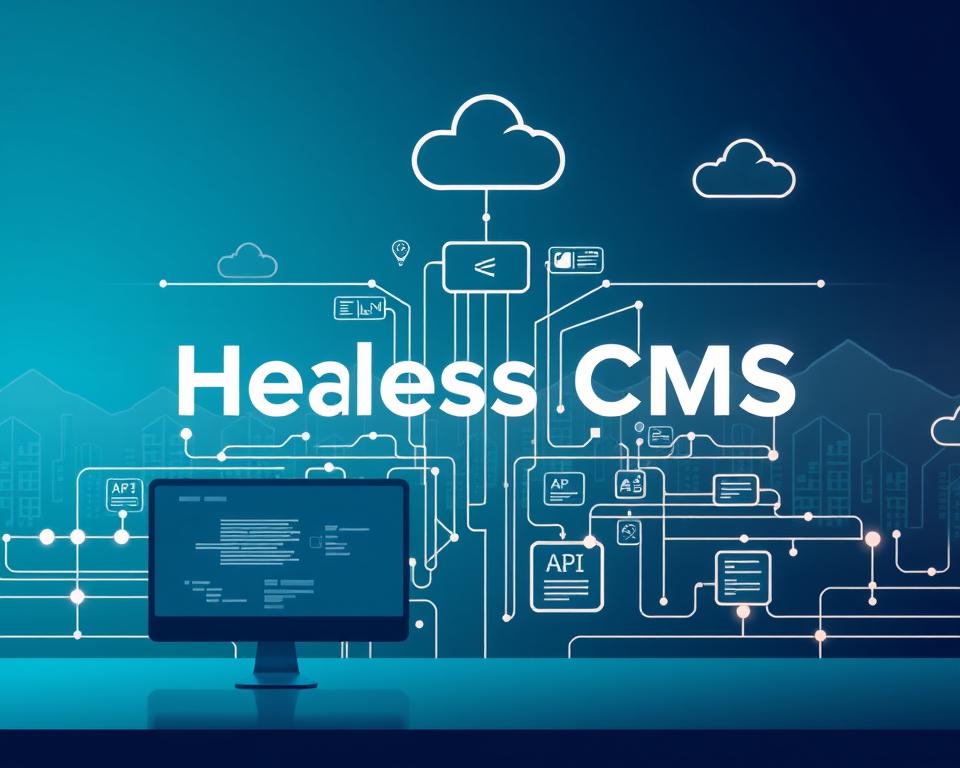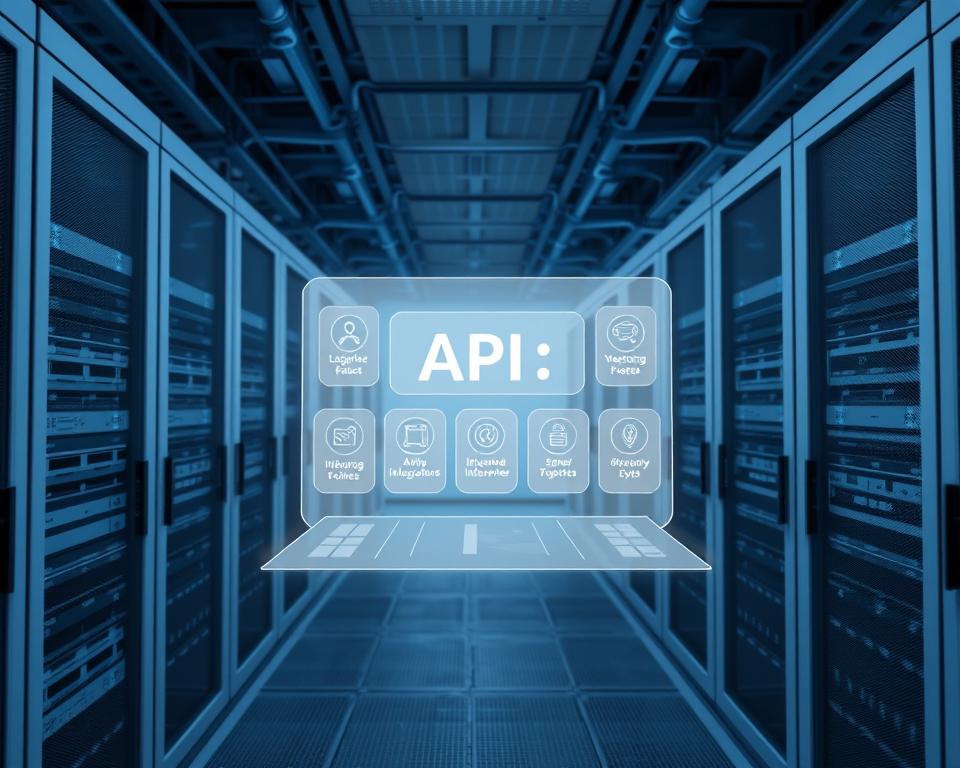The web development world is changing fast, and headless CMS is leading this change. It’s known for its flexibility, scalability, and security. More and more developers and businesses are choosing it.
Headless CMS brings many benefits to web development. It offers better security and performance. As more people want headless CMS, it’s clear it’s shaping the future of web development.
With headless CMS, developers can build custom apps and connect them with different services. This makes it a great choice for businesses wanting to stay digital leaders.
Table of Contents
Introduction to Headless CMS
Headless CMS is changing web development for the better. It makes managing content more efficient and flexible. By separating content management from the presentation layer, developers can focus on creating custom apps and integrations.
Key Takeaways
- Headless CMS is becoming increasingly popular in web development due to its flexibility and scalability.
- It provides a secure and efficient way to manage content, making it an attractive option for businesses.
- Headless CMS enables seamless integration with various platforms and devices.
- It offers improved performance and enhanced security features.
- Headless CMS is revolutionizing the way we approach web development, providing a more efficient and flexible way to manage content.
Understanding the Basics of Headless CMS
A headless content management system is a special kind of CMS. It has a backend content repository. Developers can access and manage content through APIs.
This setup lets developers build custom frontend apps. They can use their favorite programming languages and frameworks. Meanwhile, the headless CMS handles content creation, storage, and delivery.
The main feature of a headless CMS is its API-first architecture. This makes content management more flexible and scalable. Developers can build custom apps that work with the CMS.
This way, content can be managed and delivered across different channels and devices.
- Improved flexibility and scalability in content management
- Enhanced security features, such as authentication and authorization
- Increased speed and performance, due to the reduced overhead of traditional CMS architectures
In a headless CMS, content is stored in a central repository. The API is used to get and update content. This lets developers build custom apps that work with the CMS.
They can use their preferred programming languages and frameworks. The headless CMS is separate from the presentation layer. This makes content management more flexible and scalable.
The Evolution of Content Management Systems
The world of content management systems has seen big changes. These changes focus on scalability and flexibility. We’ve moved from old CMS to new headless CMS, each step bringing new ideas and better features.
One big reason for these changes is the need for scalability. Businesses need systems that can handle more data and visitors. This is crucial for growth.
Another key factor is flexibility. Creators and developers want systems that can change with new needs and tech. The move to API-first architecture has been a big leap. It makes systems more flexible and customizable.
As content management systems keep evolving, we’ll see more focus on scalability and flexibility. We’ll also see new ideas and improvements.
Some big benefits of these changes are:
- Improved scalability and performance
- Increased flexibility and customization options
- Enhanced security and reliability
Key Features Driving Headless CMS Adoption
Headless CMS is gaining popularity because it offers a secure, scalable, and fast content management system. It has API-first architecture, which lets developers get content through APIs. It also has content flexibility, making it easy to work with different platforms and devices.
Some key benefits of headless CMS include:
- Enhanced security features, such as encryption and access controls, to protect sensitive data.
- Scalability options, enabling businesses to handle increased traffic and growth.
- Improved performance, resulting in faster page loads and better user experience.
Headless CMS offers a strong and adaptable solution for managing content. It ensures top-notch security and performance for businesses.
Technical Benefits for Developers
Developers gain a lot from headless CMS. They can easily connect it with other tools and systems. This makes their work flow better. They can also use their favorite programming languages and frameworks, making their job easier.
Some key benefits for developers include:
- Flexibility in choosing programming languages and frameworks
- Scalability to handle large volumes of traffic and data
- Enhanced security features to protect against cyber threats
Using a headless CMS lets developers build strong and scalable apps. They don’t have to worry about the limits of old CMS platforms. It also lets them create complex and customized apps. This is great for businesses that want to stay ahead.
Impact on Content Creation and Publishing
Headless CMS has changed how we create and publish content online. It lets developers share content on many platforms and devices. This makes it a key part of web development.
This change has made it easier for businesses to work faster. With a headless CMS, developers can focus on the design. Meanwhile, content creators can publish without needing to know a lot of tech. This helps use a content management system to its fullest.
Streamlined Workflow
A headless CMS makes work flow better by separating content creation and publishing. Developers can work on the design while content creators publish without stopping them.
Multi-Channel Publishing
With a headless CMS, businesses can share content on many platforms like the web, mobile, and social media. This helps them reach more people and give a consistent experience everywhere. It’s a big part of modern web development and using a content management system.
Content Reusability
A headless CMS also makes it easy to reuse content. Businesses can create content once and use it everywhere. This saves time and effort, making it a must-have for efficient content management and web development.
Performance Advantages of Headless CMS Solutions
Headless CMS solutions bring many benefits, like API-first architecture and scalability. These features help developers make websites and apps that work well under heavy use. They can also get help from top PHP web development agencies to make apps that are both fast and scalable.
One big plus of headless CMS solutions is how well they scale. This is key for apps that see a big jump in users, keeping the app running smoothly. Thanks to scalability in API-first architecture, these solutions can handle lots of data and users without slowing down.
In summary, headless CMS solutions are great for developers aiming to create top-notch apps. By using API-first architecture and scalability, developers can build apps that are quick, responsive, and can grow with their users’ needs.
Integration Capabilities and API Management
Headless CMS offers many ways to integrate and manage APIs. This lets developers build custom solutions that are both flexible and secure. It makes it easy to connect with other services, improving the CMS’s functionality.
Using a headless CMS for integration and API management has several benefits:
- RESTful API implementation for easy data exchange
- Third-party service integration for extended functionality
- Custom development options for tailored solutions
Developers can make secure and adaptable solutions with these tools. They meet the needs of their organization while keeping data safe.
With the right headless CMS, companies can achieve more flexibility and security. This helps them stay competitive in the fast-changing digital world.
Why Headless CMS is the Future of Web Development
More and more people are choosing headless CMS for their web projects. Experts say it will soon be the top choice for managing content online. It offers a flexible and scalable way to build custom apps and connect them with other services.
As more businesses use headless CMS, we’ll see it get even better. It’s great for managing content in one place. It also makes it easy to link up with other apps and services.
Market Trends and Adoption Rates
The trend towards headless CMS is clear. Many companies are already seeing its benefits. They like how it offers flexibility, scalability, and the chance to customize their web projects.
Industry Expert Predictions
Experts think headless CMS will keep growing in importance for web development. It’s a flexible and scalable option. This makes it perfect for building custom apps and integrations.
Cost Considerations and ROI Analysis
When looking at a content management system, think about the total cost. This includes development, maintenance, and how it scales. A headless CMS with an API-first design can save a lot of money and offer great returns on investment. It cuts down on development time and makes it easier to grow, letting businesses focus on quality content and better user experiences.
Using a headless CMS can also cut down on infrastructure costs. It uses cloud services and grows as needed. Plus, it has enhanced security features to protect against data breaches and cyber attacks. To learn more, check out content management system platforms and their features.
Some key benefits of a headless CMS include:
- Less time and money spent on development
- More flexibility and scalability
- Better security and less risk of data breaches
By looking at these points and the total cost, businesses can make smart choices. This leads to big savings and better returns on investment.
Security and Compliance Benefits
Security is key in web development. A headless CMS offers many security and compliance perks. It includes data protection and follows rules like GDPR and HIPAA. This is crucial for companies that deal with sensitive customer info, as a breach can be very harmful.
A headless CMS boosts performance and security. It lets developers use their favorite programming languages and frameworks. This flexibility helps businesses create custom solutions that fit their needs, keeping their data safe and secure.
- Data protection features, such as encryption and access controls
- Regulatory compliance, such as GDPR and HIPAA
- Risk mitigation strategies, such as regular security audits and penetration testing
Using a headless CMS helps businesses keep their web apps secure and compliant. It also improves performance and scalability. This makes it a great choice for companies needing top security and compliance, like those in finance and healthcare.
Implementation Strategies and Best Practices
When setting up a headless CMS, think about how it will work with other tools and systems. A good plan and careful steps are key. Learning about web development frameworks and helps developers make smart choices.
The success of a headless CMS comes from how well it works with other parts. This means linking it with marketing tools, e-commerce systems, and analytics. This way, businesses can manage their content and data better.
Here are some top tips for setting up a headless CMS:
- Know what you want to achieve with the project
- Do your homework and plan well
- Build a strong and growing system
- Make sure everything is tested and works well
By sticking to these tips and focusing on integration, businesses can make their headless CMS work well. This leads to better efficiency, productivity, and results.
Common Challenges and Solutions
Businesses face many challenges when using a headless CMS. One big issue is migration. It needs careful planning to move smoothly from old systems to new ones. A good content management system helps by being flexible and scalable.
Training teams is also key. Developers and content creators must learn the new CMS. This can be done with training, documentation, and support. For more info, check out web development resources.
Some common challenges and solutions include:
- Technical hurdles, such as integrating with existing systems and ensuring compatibility with different devices and browsers.
- Security concerns, such as protecting sensitive data and preventing unauthorized access to the headless CMS.
- Scalability issues, such as handling high traffic and large volumes of content.
By tackling these challenges and finding solutions, businesses can make the most of their headless CMS. This leads to achieving web development goals. A headless CMS, combined with a good content management system, creates a strong web development platform.
Real-World Success Stories
Many companies have found success with headless CMS solutions. They’ve reached their web development goals thanks to these tools. These stories show how a headless CMS can make things more flexible and scalable.
Some companies have used headless CMS to launch new sites and apps. This has boosted their online presence and how they connect with customers. For example, a company might use it to make a web development project that works well on many devices. This gives users a smooth experience.
- Improved content management and delivery
- Enhanced customer experience through personalized content
- Increased scalability and flexibility in web development projects
These stories show how headless CMS can change the game in web development. It helps companies create new and effective online experiences.
Future Trends in Headless CMS Technology
The world of headless CMS is always changing. New trends and technologies pop up every year. Looking ahead, API-first architecture will be key in the industry. Headless CMS solutions are ready to meet the growing need for scalability and flexibility.
Headless CMS is great because it works well with other tech and systems. This makes it perfect for businesses wanting to create complex digital worlds. As it gets better, we’ll see more cool uses of headless CMS, like artificial intelligence and machine learning.
Emerging Features
- Increased use of AI and machine learning to enhance content management and delivery
- Improved scalability and performance, thanks to advancements in API-first architecture
- Enhanced security features, such as encryption and access controls, to protect sensitive data
Predicted Developments
The headless CMS market is getting bigger, and we’ll see new things soon. Big companies will start using headless CMS more. Also, the market will grow in new places.
To create the SEO-optimized HTML content for section 16 of the article, I will follow these steps:
1. List the key SEO keywords to be incorporated: flexibility, security.
2. Plan the HTML structure, including headings, paragraphs, and any other relevant tags.
3. Write text according to the provided guidelines, ensuring it meets all specified requirements.
4. Draft the content, ensuring it meets all specified guidelines and does not exceed the 100-300 word limit.
5. Following formatting as relevant: Include bulleted or numbered list to present information in a structured manner, IMAGES, Italics, short several paragraphs.
6. The beginning of the text should begin uniquely and harmoniously, without repeating what was written in the sections before.
7. The density of any word should not add up to 2%. Analyze this, and if anything, rewrite until you achieve this result.
8. Structure the content using appropriate HTML tags, starting with an
tag for the main heading.
9. Review and refine the content to ensure it meets all requirements, including the word count (100-300 words) and Keyword density from 1 to 2%.
10. Present the final, formatted HTML content.
Selecting the Right Headless CMS Platform
When picking a headless CMS, think about flexibility and security. It should let you manage content on various channels and devices safely. For more on choosing the right CMS, check out this resource.
Key things to look at when choosing a headless CMS include:
- Evaluating the features and benefits of different platforms
- Assessing the scalability and performance of the platform
- Considering the level of customization and integration required
By carefully looking at these points and your organization’s needs, you can pick a headless CMS. It should offer the flexibility and security you need for your web development goals.
Conclusion
The rise of headless CMS is changing web development. It brings many benefits, like better flexibility and security. As the digital world grows, more businesses will use headless CMS to make their websites better.
Using headless CMS lets companies manage their content in new ways. It makes their online presence stronger. Experts say this technology will be key for web development’s future.
If you’re a developer or a business leader, think about using a headless CMS. It’s a smart move for the future. Keep up with trends and best practices to lead in the digital world.



















